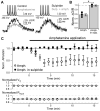Dopaminergic modulation of axon initial segment calcium channels regulates action potential initiation
- PMID: 21040850
- PMCID: PMC2987607
- DOI: 10.1016/j.neuron.2010.09.026
Dopaminergic modulation of axon initial segment calcium channels regulates action potential initiation
Abstract
Action potentials initiate in the axon initial segment (AIS), a specialized compartment enriched with Na(+) and K(+) channels. Recently, we found that T- and R-type Ca(2+) channels are concentrated in the AIS, where they contribute to local subthreshold membrane depolarization and thereby influence action potential initiation. While periods of high-frequency activity can alter availability of AIS voltage-gated channels, mechanisms for long-term modulation of AIS channel function remain unknown. Here, we examined the regulatory pathways that control AIS Ca(2+) channel activity in brainstem interneurons. T-type Ca(2+) channels were downregulated by dopamine receptor activation acting via protein kinase C, which in turn reduced neuronal output. These effects occurred without altering AIS Na(+) or somatodendritic T-type channel activity and could be mediated by endogenous dopamine sources present in the auditory brainstem. This pathway represents a new mechanism to inhibit neurons by specifically regulating Ca(2+) channels directly involved in action potential initiation.
Copyright © 2010 Elsevier Inc. All rights reserved.
Figures







References
Publication types
MeSH terms
Substances
Grants and funding
LinkOut - more resources
Full Text Sources
Other Literature Sources
Molecular Biology Databases
Miscellaneous

